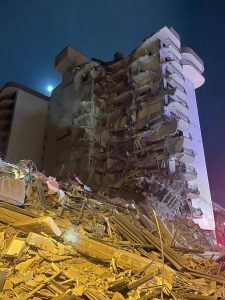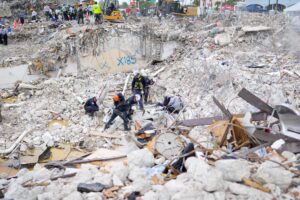Preliminary report finds weaknesses

Champlain Towers South Condominium, Sunrise, FL, June 25, 2021. Credit: Miami-Dade Fire Rescue
Federal investigators may have found the root of the tragic Surfside Condo Collapse that shook the Miami community three years ago: faulty support columns in the garage that ran underneath the complex and the adjoining pool deck. Upon examining the site and conducting tests, investigators from the National Institute of Standards and Technology (NIST) theorized that the steel-reinforced concrete pillars that held up the parking garage at Champlain Towers South were not up to construction standards when they were built in 1980 and were only half the strength they should have been. To exacerbate the problem, much of the steel had been corroded, further weakening the garage – which the pool and condo structure were built on top of. When eyewitnesses saw the pool deck collapse down into the parking garage underneath in the early morning of June 24, 2021, they did not know that key structural support beam for the condo had also been destabilized. Between four to seven minutes later, the 12-story beachfront property lay in rubble and took 98 people’s lives with it. Investigators say that when the beam failed, its tower section was squashed down and the neighboring section fell on top of it – however they’re still evaluating whether the pool deck collapsed on its own or something else within the building triggered the structural failure.

Local and federal task force crews continue to work day and night at the collapse site of the Champlain Towers South in Surfside. As of July 10, 11,595 cubic yards of rubble had been removed from the site. Courtesy, Miami-Dade Fire Rescue
Several photographs exist of the pool deck weeks before its collapse showing large cracks along the concrete planters along the perimeter of the pool, which clearly showed the stress the structure was under, according to investigators. Conversely, there are accounts from surviving residents stating they heard a loud banging in the walls before the deck failed, adding to the idea of a triggering event to cause the entire collapse. Investigators are weighing all these claims and continuing to say that current results are preliminary. “The implications of our recommendations are very large,” Glenn Bell, one of the lead investigators, told an advisory panel, “and we feel pressure to get this right.”
Findings of this scale can impact future building codes, but the NIST cannot change codes itself, only make recommendations. “Bringing about the changes that may be required based on the lessons that we learned may not be easy,” lamented Bell, something that has continued to outrage families of the victims who are searching for some semblance of justice among the rubble three years after the tragedy. While almost $1 billion in settlements have been divided among the affected families, no involved parties have admitted any wrongdoing. A criminal investigation is pending the outcome of the final NIST report, expected next year.
LMA Newsletter of 3-25-24

